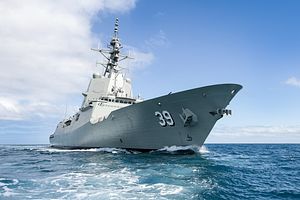The Royal Australian Navy’s (RAN) first-of-class air warfare destroyer HMAS Hobart successfully passed the first stage of sea trials off the coast of South Australia, the Air Warfare Destroyer (AWD) Alliance announced in a September 24 press release.
“This first phase of sea trials, conducted over several days in the local South Australian waters, marks the successful testing of the ship’s hull, propulsion and navigation systems. A second phase of more advanced trials will take place in early 2017 when Hobart trials its combat and communications systems,” AWD Alliance General Manager Lloyd Beckett said.
The AWD alliance is the project coordinator responsible for the construction of the Hobart-class Hobart-class –the ships are based on the Navantia-designed Álvaro de Bazán-class frigate (aka F-100) in service with the Spanish Navy–and manages the works of Australian shipbuilder ASC, mission systems integrator Raytheon Australia, and the Australian Department of Defense.
The successful completion of builder sea trials occurred two years late following a number of delays in the Hobart program and cost overruns. There has also been repeated criticism that the Hobart-class’ Aegis Combat system is outdated and will need to be expensively upgraded given that the U.S. Navy already developed a more advanced version of Aegis.
U.S. defense contractor Lockheed Martin has begun testing and integrating the Aegis combat system aboard the lead vessel of the class in March 2016. The Hobart-class program is the largest defense procurement project ever undertaken by Australia to date with total cost estimated to be over $8 billion. Around half of the money has been earmarked for upgrades once the ships have been commissioned.
As I reported previously (See: “Australia Begins Construction of Final Air Warfare Destroyer”):
The 7,000-ton Hobart-class will be the first vessels of the Royal Australian Navy built around the U.S. Navy’s Aegis Combat System (…)
In addition, the ships will be equipped with advanced sonar systems and surface-launched torpedoes for anti-submarine warfare operations, and the Harpoon anti-ship missile system for use against surface threats, among a host of other armaments. The ships will also be capable of launching helicopters and unmanned aerial vehicles (UAVs) from their flight decks.
Although called air warfare destroyers, the ships “will be multi-purpose weapons platforms that can be used for anti-surface and anti-submarine warfare operations, as well as gunfire support roles, next to the defending naval task forces from aircraft and missile attacks,” I explained elsewhere.
The lead ship of the class, HMAS Hobart, will take to the sea again for the second round of trials in early 2017. It will officially be handed over to the RAN in June 2017, followed by the HMAS Brisbane in September 2018, and the HMAS Sydney in March 2020.
































